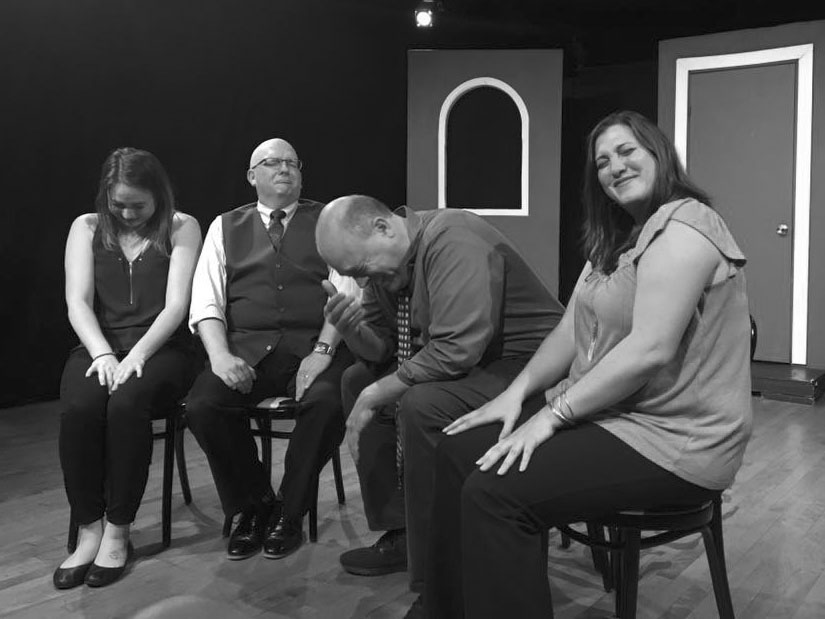
What is “Yes, and”?

Improv as a training and development tool
January 10, 2019
The Value of “Yes, &”
April 8, 2021Yes, and
If you ever done any improv training at all for your business or personal life you’ve heard of the concept of “yes and”. This may be the most powerful and least understood concept in all of improv. Powerful and that it allows us to work with each other and connect with each other quickly to build a narrative that no one is controlling and everyone is adding to, to make a shared narrative. Least understood because the distillation of a concept into two words leaves a large margin for error.
As someone has been teaching improv since early 1990s I wanted to talk about this issue. To bring light on the great and powerful parts of “Yes, and”, but also to clarify it and contextualize it for the neophyte who is wishing to use this powerful tool at work.

E=MC2
E=MC2 is a simple enough concept to grasp. It means that the amount of energy produced is equal to mass times the speed of light squared. Pretty simple straightforward (right?). However, I am not a physicist. I have no idea in actuality what that means. It does allow me to enjoy my science fiction and I can feign to understand how a replicator works on Star Trek.
“Yes and” is a similar type of concept. It is so simplified that everyone thinks they gets it. After all, it is just two, three letter words, how could I not understand that? But Einstein’s equation of E=MC2 is only 5 characters. The truth is that “Yes, and” is a simple concept to grasp, but using it effectively is more complicated/nuanced and understanding it is even harder. Once you unlock all that this formula has to offer you have the key to help you make stronger relationships, keep employee retention up and become a better leader. So over the course of the next few blogs I like to walk us through some of the nuances of the concept of “yes, and”.
Eric Farone
Partner, Apixii - Applied Improvisation Co-Owner of Bovine Metropolis Theater in Denver.
The Whys
How the concept of “Yes, and” is thought of today is fairly simple. Business people when first introduced to the concept see it as a valuable tool for brainstorming. Putting “yes, and” in the closed container of an ideation session, where there are no bad ideas, seems like a safe use of “Yes, and” to the person who secretly loves the status quo.
Those who have been using “Yes, and” for a while may look at it as a shorthand way of reminding them to collaborate. They use it as a way to remind them that they do not know all the answers, nor does anyone else. However leadership there are times when we think of ourselves as having to be the repository of all knowledge. This is a false paradigm that everyone falls victim to now and then. “Yes and” gives us the formula for us to be more collaborative, inclusive, and come up with better decisions than we could have come up with ourselves. So why is it so hard for us to say “yes and” on a consistent basis?
No
I had siblings growing up and I’m blessed to have children of my own. Many kid’s first words is the word “no”. Kids do this for many reasons; the prevailing concept is that they were told “no” a lot as little babies by parents trying to keep them safe. When a sibling comes around some children start to use “no”more as a way to carve out their own territory and claim are space in an effort to discover their individuality (or maybe they just really want that cookie).
“No’s” are powerful. Years ago I read a study from the University of Colorado that it takes two “yeses” to overcome and a “no”. A “no” stops us; it protects the status quo by keeping the unknown at bay and hopefully keeping a safe.
Let’s talk more about protecting the status quo. The protection of the status quo seems like a reasonable idea if everything is going well and you don’t need to grow. However, status quo tends to stagnate us and retard any growth and keep us from moving forward. And since the universe and time are constantly moving forward and life is about change, a “no” actually move will move us backwards (in the cosmic sense). It keeps us frozen in a time that is no longer in the present. It’s like getting paid the same amount of money today as you did when you were 18. That money was fine then, but now everything costs more, your circumstances have changed and that money won’t go far at all.
Yes
If “no” is “bad” then “yes” has to be better, right? A “yes” at its base level is an acknowledgment. It lets the person speaking know that you have heard them. That all seems well and good, but a “yes” all by itself is also signifying that you have no skin in the game. That you just don’t care that you’ve checked out.
For example think about this exchange:
Partner 1: Hi Honey, do you want to go out to eat tonight?
Partner 2: Sure.
Partner 1: How about Pho?
Partner 2: Sounds good.
Partner 1: Afterwards maybe we could go see a movie?
Partner 2: Perfect.
Partner 1: Do you want to see that new English period piece or the Sci-fi one?
Partner 2: You pick.
Partner 1: I guess the period piece.
Partner 2: Fine.
(Scene)
Partner 2 to seems pretty easy-going, but partner number one is doing all the work. They are putting all the options out on the table and partner two is just rubberstamping their options.
Put yourself in the place of partner one. How long would it take until you ask “Are you distracted?” or “Is this a bad time?” If this pattern continued on a daily basis one might even assume that your partner has checked out of the relationship altogether and just doesn’t care.
Although a “no” protects status quo and can lead to many fights, a “yes” by itself can actually be more troubling. Because a “no” means that you might have an opinion about the subject that differs from your partner’s, but a “yes” alone may mean that you don’t care enough to have an opinion.
Yes, But
A “yes, but” to the person hearing it feels like “I hear you, but you are wrong” or “…but I don’t agree with you”. Some of us feel like a “yes, but” is an acknowledgment of what the person said, however once you say the word “but” you are discounting everything that the person said before that. Here the acknowledgment you get from the “yes” is more a diminishment than an affirmation that I have heard you. Let’s look at a “yes, but” played out with our two partners above may look like this:
Partner 1: Hi Honey, do you want to go out to eat tonight?
Partner 2: Sure.
Partner 1: Do you want Chinese, Italian, Vietnamese or Greek?
Partner 2: You pick.
Partner 1: Greek.
Partner 2: Yeah, but didn’t we have Greek for lunch?
Partner 1: Okay, Italian.
Partner 2: Yeah, but I think that might be too heavy.
Partner 1: Do you want Chinese or Pho?
Partner 2: You pick. I’m easy
(Scene)
I have heard this exchange above described as a high maintenance person trying to sound low maintenance. That is exactly what a “yes, but” is. It’s just a fancy “no” that tries to make the person saying it feel better for saying “no”. Don’t do it.
Yes, And
We talked about how “yeses” are an acknowledgment. It says I hear you. The “yes” is a huge element, without hearing what we are saying “yes” to there can be no “and”. It is the “and” part that is so crucial and powerful. The “and” actually lets the person know that they have been really heard. Because not only do I have to acknowledge that I’ve heard you, I must prove it by building upon what you said, which lets you know I’ve really heard you. I have to put my own sense of competition and need to be right to the side to build upon what you said.
So the “and” becomes the balancing part of the calculation. We’ll talk more about the “and” in later blogs, for now just understand that the “and” brings us into the unknown, which brings us into the future, into an unprotected space, into something new and hopefully better.
This is a quick and rudimentary summation of the basic understanding of “Yes, and” as it is today. In continuing blogs I hope to flesh it out a little more to prove the math of the simple formula “yes, and” and helps you to use it to build and enhance relationships, group dynamics and aid in leadership.
